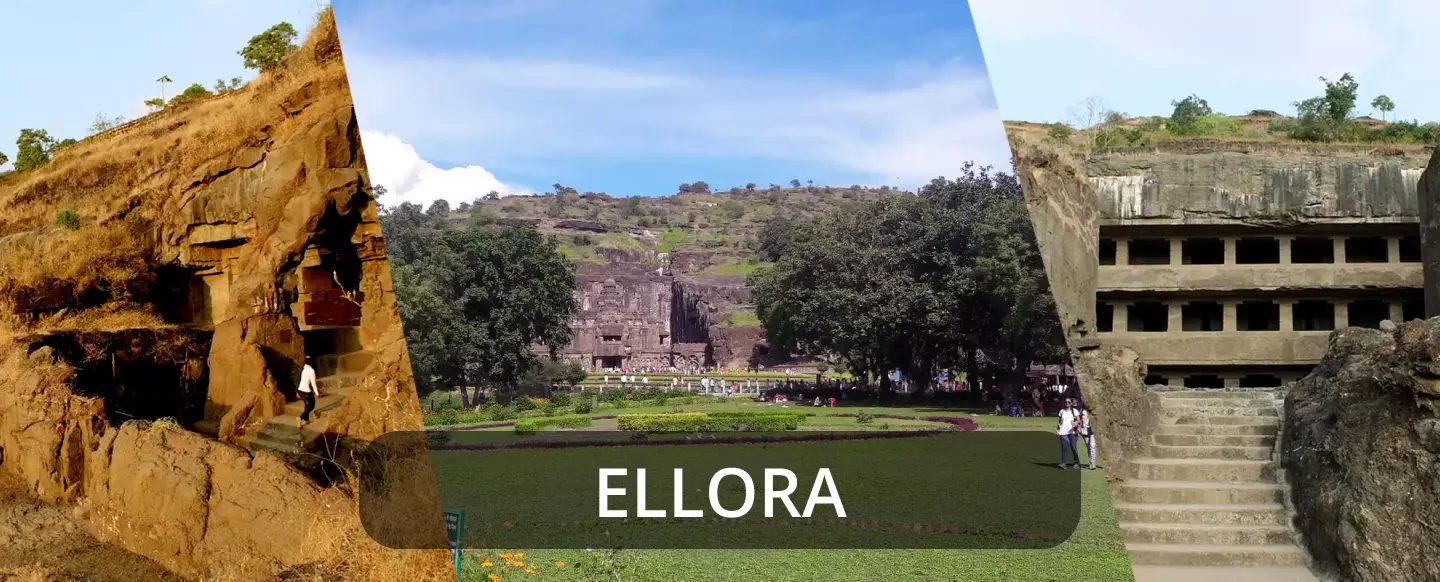
One of the largest rock-cut cave temples in the world, the UNESCO designated Heritage Site, Ellora Caves are a spectacular sigh to behold depicting a harmonious blend of three different religion – Hinduism, Jainism, and Buddhism. A long stretch of 2km wall caves, what must have been an arduous task of carving these majestic rock-caves, Ellora Caves is an amalgamation of ideas and shares creative insights which gave birth to a splendid work of art in ancient India.
Ellora Caves are a cluster of 34 monasteries and temples dug side by side in the wall of a high basalt cliff, expanding to over 2km. Built between 5th to 10th centuries, the temples in Ellora Caves are devoted to Hindu, Buddhist, and Jain faith, in which the Buddhist temples were created first during the 5th to 8th century. The structures here are in the form of Viharas or monasteries, which are huge muti-storey buildings comprising living quarters, sleeping quarters, kitchens, and other rooms. The most popular of them all is the Vishwakarma cave, also known as ‘’carpenter’s cave’’. The Hindu caves were built between 6th to 8th centuries and highlight Mount Kailasha, the humble abode of Lord Shiva, which took 100 years to complete along with some other Hindu elements. The Jain caves were constructed during the last phase of Ellora and are smaller than Hindu and Buddhist caves with detailed carvings.
Unlike Ajanta Cave, Ellora Caves are young and date back to 600 to 1000 CE depicting Hindu, Buddhist, and Jain temples. Ellora caves have over 100 caves with only 34 open to public and were unearthed from the basalt cliffs of Charanandari hills. There are 17 Hindu caves, 12 Buddhist and Jain caves with deities, engravings, and even monasteries showcasing the mythology of each religion. The caves are near to each other which depicts the harmony among different faiths and served as lodgings to the traveling Buddhist and Jain monks.
The Hindu and Buddhist caves were constructed during the Rashtrakuta dynasty while the Jain caves were made by the Yadava dynasty. It is not yet established as to which caves were built first, the Hindu or Buddhist, but several historians believe that when the Hindu caves were built the Buddhists didn’t exist. On the basis of archaeological evidence found at the sites, it was deduced that there were mainly three important phases for the construction period of Ellora – early Hindu period from 550 to 600 CE, Buddhist period from 600 to 730 CE, and the Jain and Hindu period from 730 to 950 CE.

Ellora caves are mostly about the sculpture and carvings on the walls. Many deities and idols have been ruined but the inscriptions, paintings, and carvings remain. The engravings on the walls of the Ellora Caves date back to 6th century and one of the most famous of them all is the Rashtrakuta Dantidurga etched on the mandapa of cave 15 inscribed during 753 to 757 AD. There are Hindu temples and monuments, Jain monuments, and Buddhist monuments.
Hindu Monuments : Built between 6th to 8th century in Kalachuris period, Hindu caves were constructed in two phases. Caves 14, 15, 16 were cut out in Rashtrakuta period and were dedicated to Lord Shiva along with other deities with the lingam-yoni at the center of the shrine being the highlight. One of the major highlights is the Kailasha Temple or Cave 16, which is the depiction of the abode of Lord Shiva and is the biggest single gigantic rock excavated in the world. It was built by Krishna I who was the uncle of Dantidurga.
Buddhist Monuments : Estimated to be built around 600 to 730 CE, Buddhist caves feature monasteries and shrines which comprise Bodhisattvas and carvings of the Buddha. The Vishwakarma Cave or Cave 10 constructed during 650 CE is the main attraction here. It is also called ‘’carpenter’s cave’’ as the finishing of the rock appears to be of a wooden beam. It has a 15feet tall statue of Buddha and was used as a prayer cave with eight cells and a doorway.
Jain Monuments : Nestled toward the north of the Ellora caves, Jain caves belong to the Digambara sect and were unearthed in 9th and 10th centuries. These are tinier than Hindu and Buddhist caves and have the architectural features such as mandapa and a pillared verandah. The Jain temples have figurines of Yaksa and Yaksi, gods and goddesses, and devotees displaying the Jain mythological susceptibilities during those times. Caves 30 and 32 are the major highlights here consisting of two huge statues of Indra, one an eight-armed and the other a twelve-armed one in a dancing pose. The total arms depict Indra’s poses during the dances along with other deities.
The proximity of the caves in Ellora depict the harmony the religious faith between Hindu, Jains, and Buddhists was. Ellora caves have over 100 caves out of which 34 are open to public and each of them have their own specialty. If you are short on time, then you must visit cave 1, 2, and 16.
Timings – From sunrise to sunset
Entry Fees – INR40/person (Indians), INR600/person (Foreigners)
INR25 for camera
By Air: The nearest airport is Aurangabad airport which is 100km away and is connected to major cities. You can get a bus or cab from near the airport to directly the caves.
By Train: The nearest railway station from Ellora Caves is the Jalgaon Railway Station at 60km away.
By Road: Aurangabad is easily ace via road from distinct neighboring cities and state-run buses are easily available from all cities in Maharashtra.

A series of 34 opulent rock-cut temples situated in the state of Maharashtra, the Ellora Caves are spread out in their glory for over a distance of 2km. Designated as the UNESCO World Heritage Site, the Ellora Caves are cut-out basaltic rocks that comprise 12 Buddhist Caves, 17 Hindu temples, and 5 Jain temples with a dramatic facade and intricately carved interiors.
No, Ajanta and Ellora caves are two different sets of ancient rock-cut caves and are about 100km away from each other in Aurangabad district in Maharashtra.
The Ellora caves are known for their authentic and ancient Ellora temple and sculptures and paintings of three different beliefs – Hinduism, Buddhism, and Jainism.
The Ellora monuments were built during the Rashtrakua dynasty which built the Hindu and Buddhist caves while the Yadava dynasty constructed several Jain caves.
The 12 Buddhist Ellora caves date back to 200 BCE to 600 BCE, the 17 Hindu temples date from 500 to 900 CE, and Jain temples date back to 800 to 1000 CE.
Ellora caves depict harmonious blend of Hinduism, Jainism, and Buddhism.
Copyright 2012-2022 Indiamap Digital Pvt Ltd. All rights reserved. Privacy Policy | Terms of Use